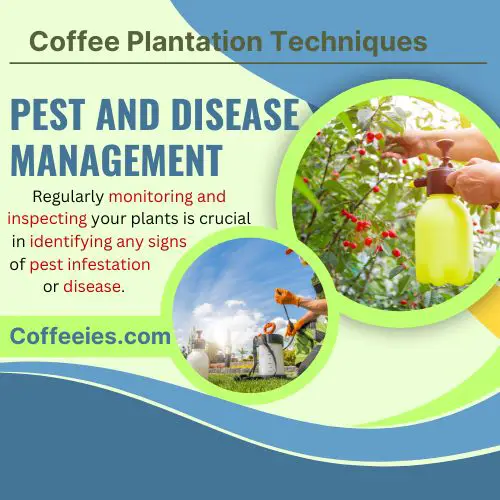Are you ready to become a coffee connoisseur? Discover the secrets of successful coffee plantation techniques and unlock the full potential of your crop.
From selecting the perfect coffee varieties to mastering pruning and training techniques, this article will guide you through every step of the process.
Get ready to delve into the world of coffee cultivation and maximize your yield with proven methods. It’s time to elevate your coffee game and brew a cup of perfection.
Summary
- The choice of coffee variety greatly impacts the quality and taste of the final product.
- Soil preparation and fertilization play a crucial role in ensuring healthy plant growth and optimal coffee production.
- Effective pest and disease management is essential for the long-term success of a coffee plantation.
- Selecting the appropriate planting technique and ensuring proper watering and irrigation methods are crucial for the proper growth and development of coffee plants.

Selecting the Right Coffee Varieties
It would help if you started by considering the different coffee varieties available for your plantation.
The choice of coffee variety will greatly impact the quality and taste of your final product.
There are numerous varieties to choose from, each with its unique characteristics and flavor profiles.
Some popular options include Arabica, Robusta, and Liberica.

Arabica is known for its delicate and nuanced flavors, while Robusta is more robust and has a higher caffeine content. Liberica, on the other hand, offers a distinct and bold taste.
It is important to research and understand the specific requirements and growing conditions of each variety before making your selection.
Once you have chosen the right coffee variety, you can move on to understanding soil preparation and fertilization, which plays a crucial role in ensuring healthy plant growth and optimal coffee production.
Understanding Soil Preparation and Fertilization
Start by evaluating the soil composition and determining the necessary amendments for optimal coffee growth.
Understanding the soil preparation and fertilization process is crucial in creating the ideal conditions for your coffee plantation.
Conduct a soil test to assess the pH levels, nutrient content, and organic matter present.
Based on the results, you can make informed decisions about the specific fertilizers and soil amendments needed to enhance the soil quality.
Organic matter, such as compost or well-rotted manure, can be added to improve soil structure and nutrient availability.
Additionally, consider using fertilizers containing nitrogen, phosphorus, and potassium to provide essential nutrients for healthy coffee plant growth.
Once you have prepared the soil, you can move on to implementing effective pest and disease management techniques to ensure the long-term success of your coffee plantation.
Implementing Effective Pest and Disease Management
To effectively manage pests and diseases on your coffee plantation, it is essential to implement a comprehensive and proactive approach.
Regularly monitoring and inspecting your plants is crucial in identifying any signs of pest infestation or disease.
By catching these issues early on, you can prevent them from spreading and causing significant damage to your crop.

Implementing cultural practices such as pruning and proper sanitation can also help reduce the risk of pests and diseases.
Additionally, it is important to select coffee varieties that are resistant to common pests and diseases in your region.
Integrated pest management techniques, such as using biological controls and organic pesticides, can be employed to minimize the use of synthetic chemicals.
By taking a proactive approach and implementing these strategies, you can effectively manage pests and diseases on your coffee plantation.
Exploring Different Coffee Plantation Techniques
Try experimenting with different coffee plantation techniques to optimize the growth and yield of your coffee plants. There are several methods you can explore, such as direct seeding, transplanting, or using raised beds.
- Direct seeding: Direct seeding involves planting the coffee seeds directly into the ground, allowing them to germinate and grow naturally.
- Transplanting: Transplanting, on the other hand, involves starting the seeds in a separate location before moving them to the final plantation site. This method ensures better control over the growing conditions.
- Use raised beds: Another option is to use raised beds, which provide better drainage and aeration for the plants’ roots.
By trying these different techniques, you can determine which one works best for your coffee plantation. Now, let’s move on to optimizing watering and irrigation methods to further enhance the growth of your coffee plants.
Optimizing Watering and Irrigation Methods
Once you have determined the best planting technique for your coffee plants, it is important to optimize your watering and irrigation methods to ensure their proper growth and development.
Proper watering is crucial in maintaining the health and productivity of your coffee plants. Here are some tips to help you optimize your watering and irrigation methods:
- Use drip irrigation systems to provide a slow and steady water supply directly to the plant roots.
- Monitor soil moisture levels regularly and adjust watering accordingly to prevent overwatering or underwatering.
- Mulch around the base of the plants to retain soil moisture and prevent evaporation.
- Consider implementing a rainwater harvesting system to reduce reliance on freshwater sources and promote sustainability.
Mastering Pruning and Training Techniques
You can achieve mastery in pruning and training techniques to ensure the healthy growth and productivity of your coffee plants.
Pruning is essential for removing dead or diseased branches, promoting air circulation, and shaping the plant to improve sunlight exposure.
By cutting back certain branches, you can control the size and shape of the coffee tree, making it easier to manage and harvest.
Training techniques, such as trellising or staking, can be used to support the plant’s growth and prevent it from falling over under the weight of the coffee cherries.
By mastering these techniques, you can create a well-structured coffee plantation that maximizes yield and facilitates harvesting operations.
Now, let’s move on to the next section and explore how proper harvesting practices can further enhance your coffee’s yield.
Maximizing Yield With Proper Harvesting Practices
Happy Farm YouTube Channel
To maximize the yield of your coffee plants, it is important to implement proper harvesting practices. By following these techniques, you can ensure a bountiful harvest and maintain the quality of your coffee beans:
- Harvest when the cherries are fully ripe: This ensures that the beans have reached their maximum flavor potential.
- Use selective picking: Only pick the ripe cherries, leaving the unripe ones to mature further.
- Handle the cherries with care: Avoid damaging the cherries during harvesting to prevent fermentation or mold growth.
- Harvest regularly and timely: Regular harvesting prevents overripening and ensures a continuous supply of fresh cherries.
Implementing these practices will not only increase your coffee yield but also result in high-quality beans that are sought after in the market. Remember, proper harvesting practices are essential for maximizing your coffee plantation’s productivity.
Post-Harvest Processing and Quality Control Techniques
For optimal results, carefully implement post-harvest processing and quality control techniques to ensure the highest quality of your coffee beans.
After harvesting, the coffee cherries need to undergo several steps to remove the outer layers and extract the beans.
One common method is the wet processing method, where the cherries are pulped, fermented, washed, and dried. This method helps to enhance the flavor and aroma of the coffee.
Another method is the dry processing method, where the cherries are dried directly under the sun. This method is more suitable for certain coffee varieties and can result in a unique flavor profile.
Once the beans are dried, they undergo a series of quality control tests, including cupping, to evaluate their taste, aroma, and overall quality.
By carefully following these post-harvest processing and quality control techniques, you can ensure that your coffee beans meet the highest standards and provide an exceptional coffee experience.
Frequently Asked Questions
1. What Are the Best Practices for Storing Coffee Beans After Harvesting?
After harvesting coffee beans, the best storage practices involve keeping them in a cool, dry place, away from direct sunlight or moisture. Make sure to use airtight containers to maintain freshness.
2. How Long Does It Take for Coffee Plants to Start Producing Beans After Planting?
It usually takes about three to four years for coffee plants to start producing beans after you plant them. So, be patient and take good care of your plants during that time.
3. Are There Any Organic Methods Available for Pest and Disease Management in Coffee Plantations?
Yes, there are! You can use natural predators, like ladybugs, and organic sprays made from neem oil to protect your coffee plants.
4. What Are the Factors to Consider When Choosing the Right Time to Harvest Coffee Beans?
When choosing the right time to harvest coffee beans, factors to consider include the maturity of the beans, weather conditions, and desired flavor profile. Harvesting too early or too late can impact quality.
5. Can You Provide Some Tips for Maintaining the Quality of Coffee Beans During Post-Harvest Processing?
To maintain the quality of coffee beans during post-harvest processing, make sure to properly dry and store them. Though it may seem time-consuming, the extra effort is worth it for a delicious cup of coffee.
Conclusion
Congratulations! By implementing these coffee plantation techniques, you’re on your way to creating a thriving and bountiful coffee plantation.
Picture yourself surrounded by lush green fields, the aroma of freshly brewed coffee wafting through the air.
Your hard work and dedication have paid off as you sip a cup of your own homegrown, rich, and flavorful coffee.
Embrace the satisfaction and pride that comes with a successful harvest, knowing that you’ve created something truly special. Cheers to the future of your coffee plantation!
Resources Used For Research
- Frequency and distribution of Antestiopsis orbitalis Westwood (Hem., Pentatomidae) in coffee plantations in Burundi
- Mapping coffee plantations with Landsat imagery
- Investigation method for shaded coffee plantation detection using aerial photography
- Coffee plantation area recognition in satellite images using Fourier transform
- Proposed Techniques to Supplement the Loss in Nutrient Cycling



